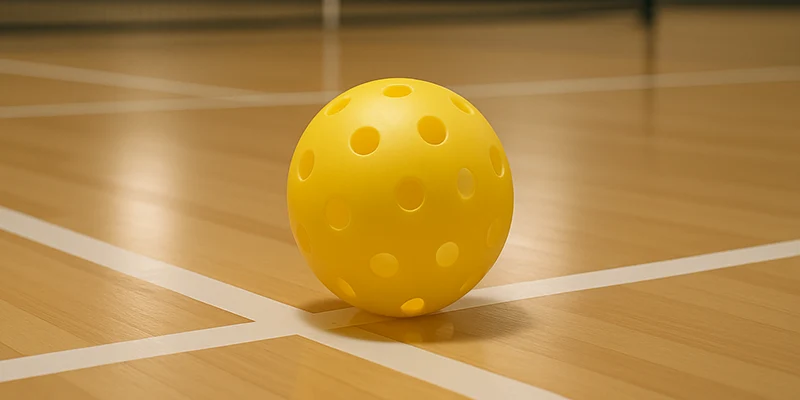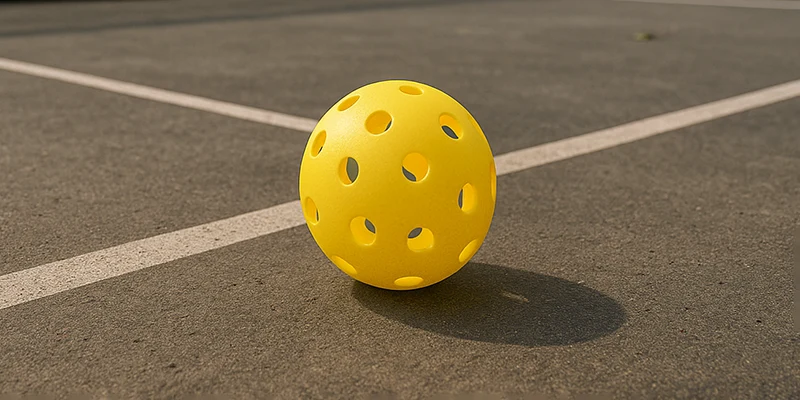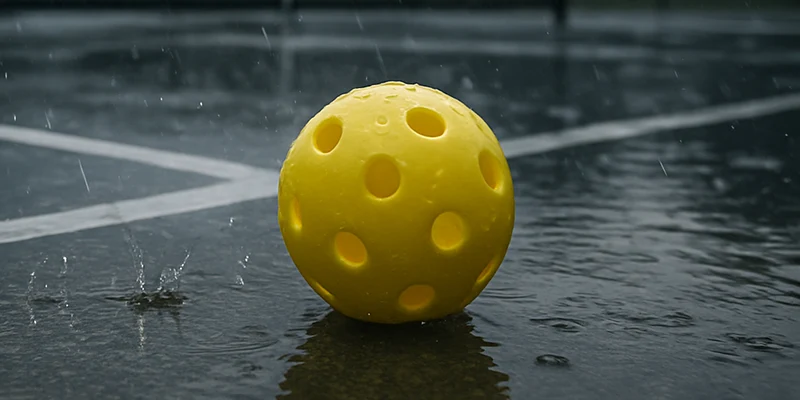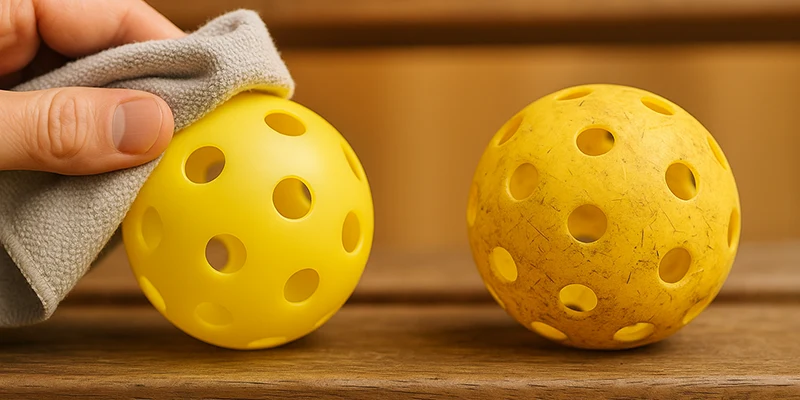5 Key Differences Between Indoor and Outdoor Pickleball Balls

CEO & Technical Expert at Pickleball Equipment Company (Art Pickleball)
Specialize in manufacturing pickleball paddles, pickleball balls, and pickleball accessories.

Pickleball, a fun and challenging sport, has been gaining more and more players worldwide. For any pickleball enthusiast, selecting the right ball is crucial for an optimal playing experience. Though it might seem straightforward, choosing the right ball involves a bit more than just picking one up from the shelf, especially when you’re playing indoors or outdoors.
In this article, we’ll dive into the differences between indoor and outdoor pickleball balls, providing you with all the information you need to make an informed decision. Whether you’re a beginner or an experienced player, this guide will help you choose the right ball based on your playing environment.
5 Key Differences Between Indoor and Outdoor Pickleball Balls
The following information is sourced from the usapickleball.org’s official document: USA Pickleball Equipment Standards Manual.
1. Number of Holes
The number of holes in a pickleball ball plays a crucial role in determining its aerodynamics, stability, and overall performance. While pickleballs may look like simple plastic spheres at first glance, the carefully designed holes serve an important purpose: ensuring that the ball flies consistently and reacts predictably during the game.
Indoor Balls
Indoor pickleball balls typically feature 26 larger holes. The primary purpose of these larger holes is to reduce air resistance, making the ball travel slower and with more control. Indoor courts, typically made of smooth surfaces like wood or plastic, offer minimal interference, so the ball needs to behave predictably. The larger holes help to maintain a slower, more controlled trajectory, which is perfect for precision shots and soft bounces that are common in indoor gameplay. Additionally, the larger holes make it easier for players to manipulate the ball during rallies, allowing for greater control over its direction and speed.
Outdoor Balls
Outdoor pickleball balls are designed with 40 smaller holes, a noticeable increase in number compared to indoor balls. These smaller holes are specifically crafted to combat wind resistance, ensuring the ball maintains its stability and trajectory despite outdoor conditions. Wind is one of the biggest challenges in outdoor play, and the additional smaller holes allow the ball to cut through the wind more effectively. This makes the ball more robust, and less prone to being knocked off course by gusts of wind.
Interestingly, some outdoor balls may have two sizes of holes in one ball. This design modification can further optimize aerodynamics and allow for more control during play. The smaller holes reduce drag, helping the ball maintain its speed and flight path, which is crucial for consistent play on outdoor courts that tend to have rougher surfaces and unpredictable environmental factors.
Shaping the Flight Path
Each hole in a pickleball ball is beveled into the plastic, with uniform size and placement, although, as mentioned, some outdoor balls feature a combination of hole sizes. This uniformity ensures the ball flies in a predictable manner, with minimal deviation from the intended flight path. The design of the holes directly impacts the bounce and aerodynamics, helping to stabilize the ball for a more consistent shot trajectory.
Official Standards
According to USA Pickleball’s equipment guidelines (Section 2.D.8), the ball must have a minimum of 26 holes and a maximum of 40 holes to meet official standards for gameplay. However, the rulebook does not specify the number of holes required for indoor versus outdoor balls, which means technically, a 26-hole ball could be used for outdoor play as long as it meets the general criteria for official competition.
2. Hole Diameter
The diameter of the holes in pickleball balls is another crucial design difference that affects how the ball interacts with the air, its trajectory, and its overall performance on the court. While both indoor and outdoor pickleballs share the same basic structure, the size of their holes varies significantly. This variation influences the ball’s aerodynamics, bounce, and control, and is a key factor that differentiates indoor and outdoor balls.
Indoor Balls
Indoor pickleballs typically have wider holes compared to outdoor balls. On average, the diameter of the holes on an indoor pickleball measures 0.43 inches. These larger holes reduce wind resistance and allow the ball to travel slower, which is ideal for indoor play where the surface is smooth, and external factors like wind are minimal. The slower speed and lower bounce created by the larger holes offer players better control and precision, making them well-suited for indoor environments. Since indoor courts are typically smoother and provide less friction, the wider holes allow the ball to interact more predictably with the air, giving players the ability to control shots with greater accuracy.
Outdoor Balls
In contrast, outdoor pickleballs feature smaller holes, usually with a diameter of 0.282 inches. This reduction in hole size is designed to minimize wind resistance and ensure the ball can travel faster and more consistently through the air. The smaller holes help the ball maintain its flight path and stability even in windy conditions, which is essential for outdoor play where wind and environmental factors can alter the ball’s trajectory. This design ensures the ball retains its speed and doesn’t get easily knocked off course, making it more reliable for outdoor courts, which may have rougher surfaces and unpredictable weather conditions.
Key Differences
The difference in hole diameter between indoor and outdoor pickleballs is quite significant. Indoor ball holes are typically 40% larger than those found in outdoor balls. This large difference in size is a direct result of the differing requirements for indoor and outdoor play. While indoor balls prioritize control and precision, outdoor balls focus on stability and speed to perform well under the unpredictable environmental factors typically found on outdoor courts.
Official Standards
There are no specific regulations on the hole diameters for indoor vs. outdoor pickleballs according to USA Pickleball. The general guideline for the number of holes in a pickleball is that the ball must have a minimum of 26 holes and a maximum of 40 holes to meet official standards for gameplay, but no rules exist that mandate the diameter of those holes
3. Weight
The weight of a pickleball ball is an important factor that impacts its performance, particularly in terms of bounce, speed, and stability. While both indoor and outdoor pickleballs may appear similar in design, the weight difference is one of the key factors that sets them apart, influencing how they behave on the court.
Indoor Balls
Indoor Pickleballs are generally lighter than outdoor balls. This lighter weight is a key design feature, especially for indoor courts, where there are fewer environmental factors like wind or rough surfaces that could interfere with the game. The reduced weight helps to achieve a controlled bounce, which is particularly useful on smooth indoor surfaces like wood or plastic. The lighter ball also allows players to have better control and precision, as it is easier to handle, especially during more delicate shots.
Indoor balls typically weigh around 0.917 ounces, contributing to a more comfortable feel and allowing players to focus on refining their techniques without worrying about the ball’s behavior being influenced by external conditions. The smaller surface area of the holes (fewer holes, but larger in diameter) also plays a role in reducing the overall weight of the ball, which further enhances the control players have during play.
Outdoor Balls
Outdoor pickleballs are typically heavier than their indoor counterparts. This extra weight is designed to help the ball withstand the harsher outdoor conditions, such as wind and rougher court surfaces like asphalt or concrete. The additional weight helps the ball maintain its stability, even in gusty conditions, by reducing the effects of wind interference. Heavier balls are also less likely to be easily knocked off course, ensuring that the ball stays true to its intended path.
Outdoor balls also have more holes, which means the surface area is divided differently than indoor balls. Even though outdoor balls have 40 holes (compared to the 26 larger holes in indoor balls), the smaller hole diameter results in less material being removed, thus maintaining a slightly higher weight overall. Outdoor balls weigh on average 0.925 ounces, which is just slightly heavier than indoor balls, but the extra weight makes a subtle difference in how the ball performs on rougher outdoor courts.
The increased weight also helps improve bounce on outdoor courts, where the surfaces may be uneven or harder. A heavier ball typically bounces higher and reacts more predictably on harder surfaces, making it essential for consistent performance during outdoor play.
Weight Difference and Performance Impact
The difference in weight between indoor and outdoor pickleballs is generally small, but it does have a noticeable impact on performance. The weight difference is less than 1%, with indoor balls averaging 0.917 ounces and outdoor balls averaging 0.925 ounces. While this difference may seem minimal, it plays a significant role in stability and bounce. Outdoor conditions, including wind and rough surfaces, require a heavier ball to maintain accuracy and stability. In contrast, indoor environments benefit from the lighter ball, which is better suited for the more controlled play on smooth indoor courts.
Official Standards
According to the USA Pickleball Equipment Standards Manual (Section 2.D.4.), the ball must weigh between 0.78 and 0.935 ounces (22.1 and 26.5 grams) to meet official standards for competitive play. There are no specific weight restrictions or distinctions made between indoor and outdoor balls, meaning both types of balls must fall within this weight range to ensure they are approved for official play. Despite this, the general consensus is that the extra weight of outdoor balls provides an advantage for outdoor play by improving their aerodynamics and performance under wind and rough surfaces.
4. Hardness
The hardness of a Pickleball ball plays a crucial role in determining how it reacts during gameplay, how durable it is, and how it feels when hit. It influences factors like bounce, compression, and overall playability, making it one of the most important design features to consider when choosing between indoor and outdoor balls.
Materials and Hardness Scale
Pickleballs are typically made from various plastics or hard rubbers, with each material offering a different level of hardness. The hardness of the material is often measured using a durometer hardness test, which uses Shore D values to quantify hardness on a scale of 0 to 100, where 100 represents the hardest material.
Here’s a general breakdown of the hardness of some common materials used in making Pickleballs:
- LDPE (Low-Density Polyethylene): 40-50 Shore D
- HDPE (High-Density Polyethylene): 60-70 Shore D
- PP (Polypropylene): 70-83 Shore D
- PET (Polyethylene Terephthalate): 85-95 Shore D
The hardness of a Pickleball material directly influences how the ball behaves during play. Softer materials like LDPE or TPE (thermoplastic elastomer) tend to result in a spongier ball, which offers more drag and a slower bounce. In contrast, harder materials like HDPE or PET make for a firmer, more durable ball that bounces higher and plays faster.
Hardness in Indoor vs. Outdoor Balls
Indoor Balls are generally made from softer plastics, such as LDPE or PP, to allow for better control and a softer feel during play. The softer materials help the ball maintain a lower bounce, which is ideal for the smooth, controlled surface of indoor courts like wood or plastic. This makes indoor balls easier to handle and more predictable when hitting, offering players enhanced control during rallies.
On the other hand, Outdoor Balls are typically constructed from harder plastics, such as HDPE, PP, or PET, to increase their durability and ability to withstand the harsh conditions of outdoor play. These harder materials make the ball more resistant to wear and tear, especially in windy, sunny, or rainy conditions. The increased hardness also contributes to a higher bounce, which is necessary for outdoor surfaces, such as concrete or asphalt, that require a ball with greater resilience to perform well.
In outdoor conditions, balls must endure not only the rough surfaces of outdoor courts but also weather conditions such as humidity, wind, and extreme temperatures. The higher hardness of outdoor balls ensures that they maintain their shape and performance, even after prolonged exposure to abrasive surfaces and environmental stress.
Hardness, Bounce, and Compression
The hardness of a ball indirectly affects several other key aspects of its performance, including bounce and compression. The bounce of a ball is directly related to its hardness: a harder ball typically bounces higher, which is essential for outdoor play where high-speed play is more common, and the ball needs to react quickly and with more force on harder surfaces.
Compression, another factor tied to hardness, refers to how much the ball compresses when struck. Softer balls compress more easily and provide a more controlled bounce, which is why softer indoor balls are ideal for precision shots and controlled rallies on indoor courts.
While hardness itself isn’t regulated for indoor or outdoor balls in official rules (except for general standards for pickleball balls as a whole), the USA pickleball Standards used to require a Shore D of 40-50 for approved balls, which placed them on the low to medium end of the hardness scale.
Official Standards
According to USA Pickleball’s equipment guidelines (Section 2.D.7, No Longer Required), hardness used to be a required measurement for approval of pickleballs. The rule previously required that Pickleballs have a Shore D of 40-50, which was on the low-medium end of plastic hardness. However, this standard is no longer enforced.
Importantly, there are no specific rules for the hardness, bounce, or compression assigned to indoor or outdoor balls individually. The official guidelines do set standards for compression and bounce for all pickleballs, which are indirect ways of measuring the hardness of the ball, helping to maintain consistency in its overall performance. These standards are outlined in rules 2.D.5 and 2.D.6.
For a general idea of hardness, pickleballs typically fall within the Shore D 40-50 range, ensuring that they provide the right balance between playability and durability, regardless of whether they are used indoors or outdoors.
5. Durability
Durability is an important factor to consider when selecting a pickleball ball, as it directly impacts how long the ball will last under the stress of regular play. Both indoor and outdoor pickleballs are designed to endure a certain amount of wear and tear, but each is built to handle different environments, which significantly influences its lifespan.
Indoor Balls
Indoor pickleballs are typically made from softer materials, which, while providing better control and a more predictable bounce on smooth surfaces, also makes them more susceptible to wear. Due to their softer construction, indoor balls tend to deteriorate faster when exposed to harsh conditions, such as outdoor courts or rough surfaces. Over time, soft spots can develop on indoor balls, especially as they age, and they may lose their shape or bounce consistency. However, indoor balls generally perform well in controlled indoor environments, which makes durability less of a concern for players who primarily play indoors.
The soft material of indoor balls, while great for precision shots and comfort, leads to a shorter lifespan when used outside of their intended environment. Still, in indoor settings, these balls are likely to last a reasonable amount of time without significant degradation, making durability a secondary concern for indoor players.
Outdoor Balls
Outdoor pickleballs are built with harder plastics and additional weight, which contribute to their greater durability in rough conditions. These balls are designed to withstand the demands of outdoor play, where factors like temperature fluctuations, wind, and rougher surfaces like asphalt or concrete can put significant wear on the ball. The harder plastic used in outdoor balls makes them more resistant to cracking, splitting, or losing their shape, even after frequent use.
However, despite their increased durability, outdoor balls are still vulnerable to long-term damage from continuous exposure to harsh weather or rough surfaces. Over time, outdoor balls may show signs of wear and tear, such as cracks or surface degradation, especially in extremely cold or hot weather. Still, the design of outdoor balls ensures that they last longer compared to indoor balls under outdoor conditions.
Outdoor balls are typically built to endure frequent impacts and abrasive conditions, which makes them more durable for players who frequently play outdoors or in less-than-ideal weather conditions. While they may not last forever, outdoor balls are far more resistant to damage and maintain their shape and performance even in challenging environments.
Which is More Durable?
While both indoor and outdoor pickleballs are designed with durability in mind, outdoor balls are generally more durable due to the harder materials used in their construction. These balls are specifically built to withstand outdoor elements like wind, temperature extremes, and rougher court surfaces, which would easily wear down a softer indoor ball. However, indoor balls tend to have a longer lifespan when used in indoor settings because they are made of softer materials and are less exposed to harsh environmental conditions.
On average, indoor balls last longer in controlled indoor environments, while outdoor balls are built to endure harsh conditions but may experience quicker deterioration over time in extreme environments.
Official Standards
According to USA Pickleball’s equipment guidelines (Section 2.D.1.), the ball must be made of a durable material to meet official standards. However, the specific standards for durability do not differentiate between indoor and outdoor balls. This general guideline emphasizes that all pickleballs should be made with materials that can endure regular play, regardless of whether they are used indoors or outdoors
Suitable Playing Conditions
Indoor Courts: Wood and Plastic Surfaces

Indoor courts typically have wooden or plastic floors, which are ideal for indoor balls. The smoothness of these surfaces allows indoor balls to offer better control and feel. The larger holes and softer material help reduce excessive friction on the ball, ensuring a smoother playing experience.
Outdoor Courts: Hard Courts and Grass

Outdoor courts come in various types, including hard courts, grass, and even sand courts. Outdoor balls are designed to withstand these tougher environments, offering better bounce and durability. They perform well in the wind and maintain consistent flight even in variable weather conditions.
Environmental Factors: Humidity and Temperature

Environmental conditions like humidity and temperature can affect the ball’s performance. For example, in humid conditions, outdoor balls may become slippery, reducing control. Temperature changes also impact the hardness and bounce of the ball—high temperatures can soften it, while low temperatures can make it harder. These factors should be considered when choosing a ball for a particular environment.
User Experience and Recommendations
Player Experience
Many players, both beginners and seasoned enthusiasts, have shared their experiences regarding indoor and outdoor pickleball balls, highlighting the importance of selecting the appropriate ball for specific conditions.
For instance, a discussion on the Pickleball Facebook Group emphasizes that wind significantly impacts gameplay, with players noting that even mild breezes can alter the ball’s trajectory.
Additionally, a Reddit thread on r/Pickleball discusses strategies for playing in windy conditions, with players suggesting that using outdoor balls designed to withstand wind can help maintain control and consistency.
These community insights underscore the consensus that choosing the right ball for the environment is crucial for optimal performance.
Expert Advice
Experts in the pickleball community also emphasize the significance of selecting the appropriate ball for different playing conditions.
According to The Skilled Pickle, wind can drastically affect the trajectory and movement of a pickleball. They recommend using outdoor balls in windy conditions, as they are designed to handle such elements, ensuring more predictable gameplay.
Furthermore, All Things Pickleball provides practical tips for playing in windy conditions, advising players to adjust their grip and swing technique, use spin and placement to their advantage, and position themselves strategically on the court.
These expert recommendations align with the community’s experiences, reinforcing the importance of selecting the right ball and adapting strategies to the playing environment.
Ball Longevity and Maintenance

Durability
Outdoor balls typically have a shorter lifespan due to their exposure to hard surfaces, wind, and sunlight. Indoor balls, on the other hand, tend to last longer on smooth indoor courts. However, as with any ball, the more you use it, the sooner it will degrade, so replacing it regularly ensures a high-quality game experience.
Maintenance Tips
To extend the life of your ball, keep it clean and dry. Outdoor balls are more likely to be exposed to dirt and moisture, so regular cleaning and proper storage can significantly increase their durability. While indoor balls are less affected by environmental conditions, they should still be kept in a safe place to avoid damage from accidental impacts or extreme temperatures.
Brand Recommendations and Buying Tips
Popular Brands
There are several reliable pickleball ball brands that players trust. Brands like Franklin, Onix, and GAMMA have excellent reputations for quality and performance in both indoor and outdoor environments. According to user reviews, Franklin X-Performance and Onix Fuse are among the top choices for high-quality balls.
Buying Tips
When purchasing a pickleball ball, consider your playing environment, budget, and frequency of use. If you play outdoors regularly, investing in durable, wind-resistant outdoor balls is worthwhile. For indoor play, choose a ball that offers better control and comfort, enhancing your overall playing experience.
Conclusion
Choosing the right pickleball ball is not just about picking any ball off the shelf. It’s about understanding the differences between indoor and outdoor balls and selecting one that suits your playing conditions and needs. Whether you’re a beginner or an experienced player, knowing these key differences and recommendations will help you make the best choice for a better and more enjoyable game. For an even deeper dive into all aspects of pickleball equipment, don’t miss our comprehensive pickleball balls guide.
If you’re looking for high-quality pickleball balls, Art Pickleball is your trusted supplier. We specialize in providing custom pickleball balls tailored to your specific requirements. Whether you need indoor or outdoor balls, we offer durable, performance-oriented products designed for both casual players and competitive athletes. Contact us today to learn more about our custom services and how we can help elevate your Pickleball game!
So, remember to pick the right ball, and enjoy every match!
Frequently Asked Questions
1. Can indoor balls be used outdoors?
Although indoor balls can be used outdoors, they perform poorly in windy conditions due to their larger holes and softer material. It’s best to use outdoor balls in outdoor settings for optimal performance.
2. Are outdoor balls suitable for humid environments?
Outdoor balls are designed for durability, but they can become slippery in humid conditions, which affects their performance. Ensure the ball is dry before playing.
3. How can I tell if my ball needs to be replaced?
If your ball has visible cracks, deformed shapes, or no longer bounces well, it’s time to replace it.
4. What’s the difference between various brands of balls?
Different brands offer variations in material quality, bounce, and durability. It’s important to choose a ball from a trusted brand like Franklin, Onix, or GAMMA to ensure longevity and performance.
5. Does the color of the ball affect the game?
While the color of the ball generally doesn’t impact gameplay, some players find that choosing a brightly colored ball improves visibility, especially under certain lighting conditions.
